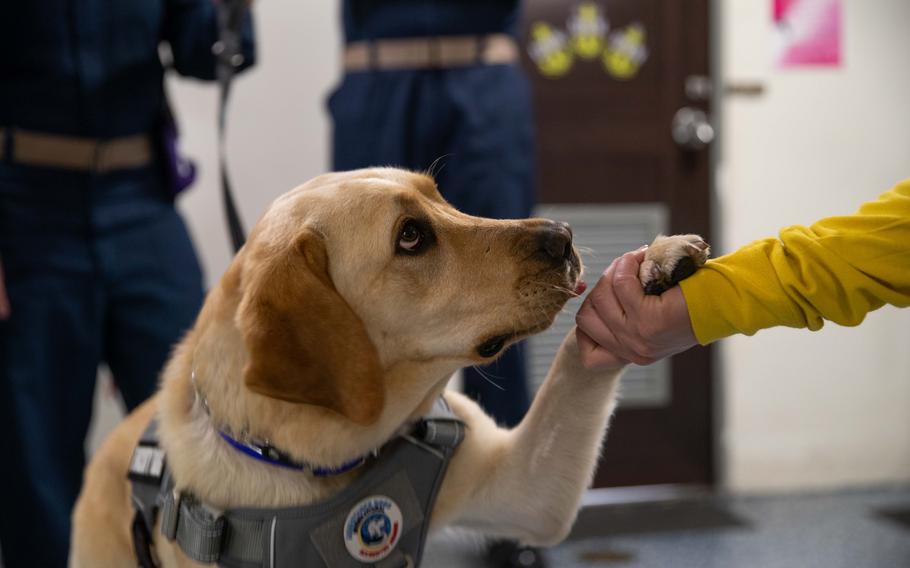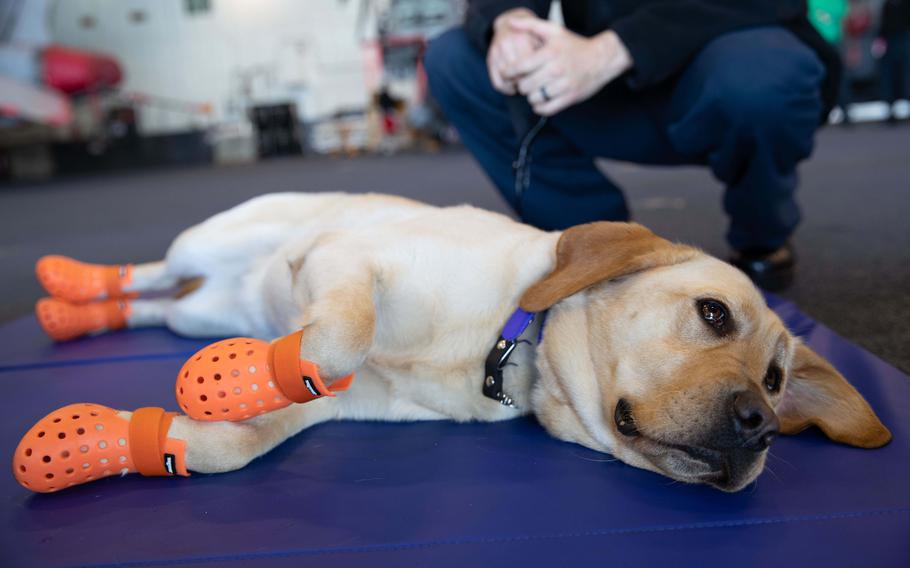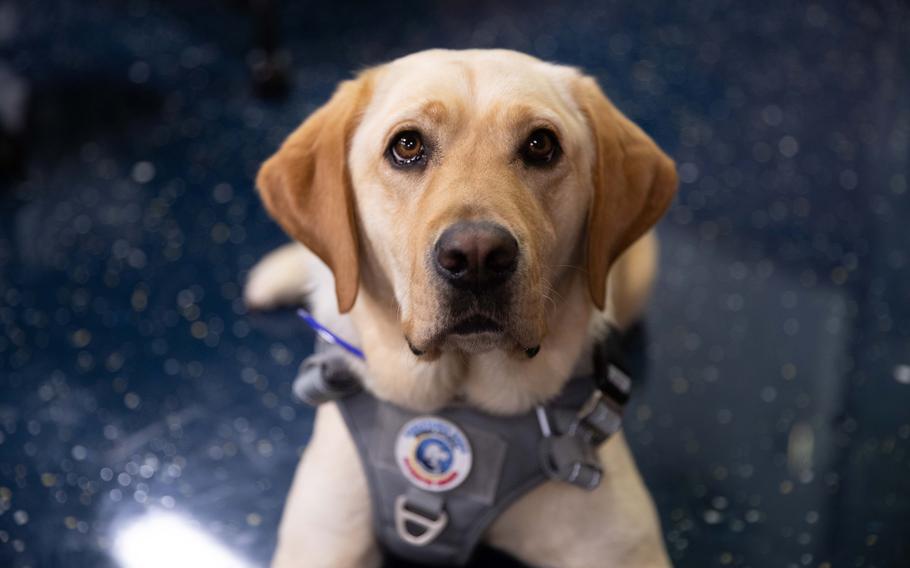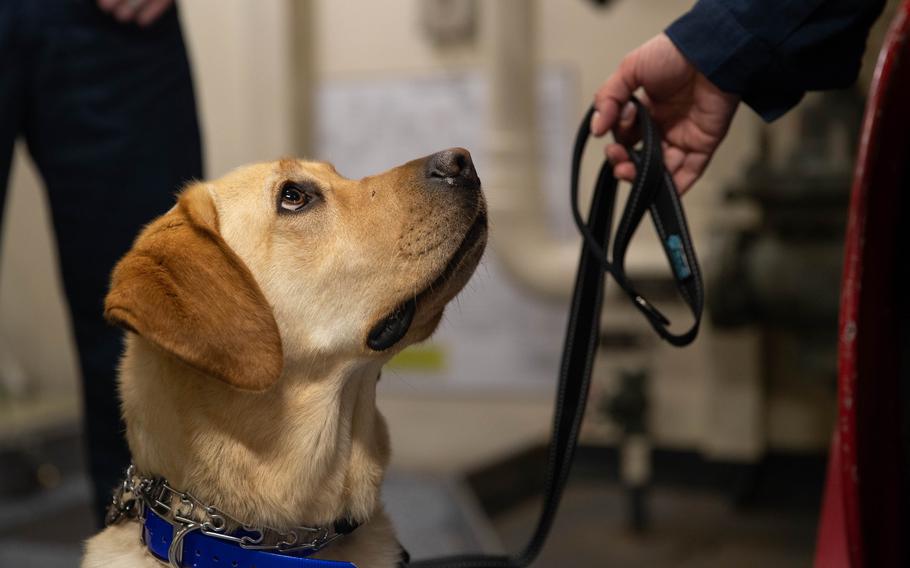
Sage is a 3-year-old yellow Labrador retriever deployed to the aircraft carrier USS Gerald R. Ford as a military facility working dog. She is part of an effort to improve quality of life for sailors deployed at sea. (Jackson Adkins/U.S. Navy)
With the help of a yellow Labrador retriever, the Navy’s newest aircraft carrier is testing a pilot program to improve quality of life for sailors at sea.
USS Gerald R. Ford is the first Navy ship to host an operational stress military working dog, said Cmdr. Genevieve Clark, a chaplain aboard the carrier.
Three-year old Sage from the Virginia Beach, Va.-based nonprofit Mutts With A Mission was aboard when the carrier left Naval Station Norfolk on May 2 for a global deployment.
With a wag of her tail, love for attention and friendly demeanor, Sage offers sailors a way to get the stress-reducing benefits that animals can bring, Navy officials said.
“In a lot of ways, Sage normalizes life,” said Clark, who completed 120 hours of training before deployment in becoming the canine’s primary handler. “Because just like people have pets at home, that’s a normal part of life that we can offer now at sea.”

Sage is the first military facility working dog deployed on a U.S. Navy ship in modern times, says Cmdr. Genevieve Clark, a chaplain and Sage's primary handler. Clark completed 120 hours of training as a handler before the aircraft carrier USS Gerald R. Ford's deployment on May 2, 2023. (Jackson Adkins/U.S. Navy)
The Navy is working to address quality of life issues and pushing to expand services amid concerns about mental health and suicide.
In 2022, 70 active-duty sailors died by suicide. There were 59 and 65 suicide deaths of active-duty sailors in 2021 and 2020, respectively, according to the Navy’s website.
Recent Navy efforts include installing waterfront resiliency centers at some bases, such as Naval Station Rota in Spain, where sailors can seek counseling or other mental health services just steps from four homeported destroyer berths.
The Navy also plans to place chaplains on all its destroyers by 2025 to help fill a critical need for counseling, Stars and Stripes reported Feb. 27.
And officials at Naval Support Activity Bahrain last month held a mental health stand down designed to raise awareness of expanded services available there.

Sage, a 3-year-old yellow Labrador retriever is now deployed aboard the USS Gerald R. Ford. The military working dog is part of Mutts With A Mission, a Virginia Beach, Va.-based nonprofit that trains service animals for disabled veterans, first responders and police officers. For about a year, the group has sent dogs to visit Navy ships and ashore facilities. (U.S. Navy)
Sage offers sailors aboard Ford more than a chance to say “hello” or cuddle for a few minutes, officials say.
A casual encounter can offer an opportunity for Clark or one of three other trained handlers to talk with sailors who may be feeling homesick, anxious or have personal or work-related problems, she said.
“It’s an entry point to further conversation where we can either help directly or connect them with the people (needed),” Clark said.
Sage is trained to assist sailors in distress with a technique to help them regulate their breathing. She also intuitively seeks out service members who need attention, Clark said.
For the past year, Mutts With A Mission has sent dogs for visits to Navy ashore facilities and ships, Brooke Corson, the group’s director, said in an email. Facility dogs also have worked at police departments, where they help to reduce the stigma associated with mental health, she said.
“They give the individual an ‘excuse’ to go seek help under the guise of visiting the dog,” Corson said. “Sometimes the dogs enable the individual to open up where they might not have otherwise been comfortable doing so.”

Sage, a 3-year-old yellow Labrador retriever from Mutts With A Mission, is trained to help sailors address stress with a technique to help them regulate their breathing. (Jackson Adkins/U.S. Navy)
Sage has taken part in thousands of hours of training, exposure and socialization since she was 8 weeks old. She’s even received training on how to use ship ladders, Corson said.
The hope is to expand the program to more ships and potentially other military services.
For example, the group is working to place a military facility working dog aboard the amphibious assault ship USS Wasp for an upcoming deployment, Corson said.
In just a few weeks, Sage has proven popular with Ford sailors, who often question her absence if Clark is alone. Sage routinely tours nearly all areas of the ship and attends staff and other meetings, Clark said.
Clark believes the program’s value will become more apparent as Ford’s mission continues.
“Sage is going to be even more important to being present with individuals or even small groups as they process the stressors that come with a deployment at sea,” she said.